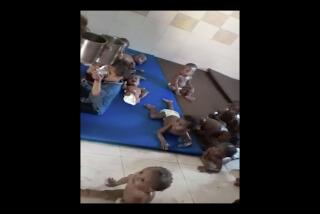Yugoslav Town Opens Its Heart, Homes to Orphans, Children From Broken Homes
- Share via
MILOSEVAC, Yugoslavia — Set in the sprawling Morava River valley of east Yugoslavia, the village of Milosevac is a haven for orphans and children from broken homes.
Nearly two-thirds of the families in the community of some 5,000 people have at one time or another fostered children, giving it a unique position in this country.
“We give our surplus of love to those who need it most and have none,” Miodrag Stevanovic, 51, a former air force officer and now an accountant, said.
Stevanovic and his wife Biljana raised two daughters of their own, but with equal loving care have brought up 12 other children over the last 25 years. Now they have taken in two brothers, aged 4 and 5.
“Raising children is not easy, but it’s parting that hurts the most,” said Biljana. “It’s like someone ripping away part of your own flesh. It’s heart-rending to watch them go.”
“It sure does hurt. But love compensates for it all. Some of them already have their own children and come to visit us. We are their ‘Mum and Dad,’ ” said her husband.
The village’s special role began in 1931, when a local doctor brought in seven abandoned children from Belgrade, some 50 miles away, and found them foster homes with affluent Milosevac families.
It soon became a matter of prestige, and a year later more than 40 orphans and abandoned children had found homes in Milosevac.
Since then, 3,785 children have been cared for by 716 families, said Mileta Djukanovic, head of the Milosevac Center for Family Placing of Children. The village has about 1,100 families. Djukanovic, whose center chooses families and sees that the children are well tended, said there are 454 foster children, aged from 1 month to 25 years, living with 178 families now.
They come from all over Yugoslavia, often finish school and marry here or move elsewhere for jobs. Word about the village is slowly traveling abroad, and childless foreigners have begun coming here from Western Europe and the United States looking for children to adopt.
Adoption procedures are clearly defined by law, and Milanka Pavlovic, a social worker, said that so far only five to 10 children are given up for adoption each year.
The center provides $45 a month per child to the families, and it pays for their clothes and summer vacation. But humanitarian motives and love for children are what really count, Djukanovic said.
“There are families which have sheltered as many as four kids at once, and it has been going on for generations.”
The center operates on modest means supplied by welfare organs in the parts of Yugoslavia where the children come from.
Djukanovic said the children under his center’s care fell into several categories: orphans, abandoned children, those whose parents were too ill to look after them or those from unstable families.
Elsewhere in Yugoslavia, there are orphanages but no other fostering communities like this.
“No institution can replace real family life and love, and that’s what makes Milosevac a unique example,” Djukanovic said.
Djukanovic, 59, has worked 24 years in the center and looks much younger than his age. “You just can’t grow old working with children,” he smiled.
Milomir Djuric, 36, who earns a mere $120 a month at a brick factory and has three young daughters of his own, has taken three children from the center for fostering.
“It’s hard to make ends meet on a small wage, but we grow our own vegetables, and if you can feed three mouths, you can just as easily feed six,” Djuric said.
More to Read
Sign up for Essential California
The most important California stories and recommendations in your inbox every morning.
You may occasionally receive promotional content from the Los Angeles Times.













